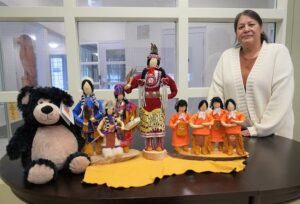Sacred corn husk dolls bring remembrance, support to Indigenous child and family services in Ontario

By Laura E. Young
SUDBURY – Delicate yet packing significance that belies their size, the sacred travelling Corn Husk dolls are more than just exquisite works of art.
The dolls and the Jordan’s Principle plush bear who accompanies them are making their way along the northern stretch of the Great Lakes watershed as part of a 13-month journey with the 13 agencies of the Association of Native Child and Family Services Agencies of Ontario (ANCFSAO).
They were recently in the care of Kina Gbezhogomi Child and Family Services (Kina) at their Sudbury branch. The Corn Husk Dolls were housed at Kina’s Enjimaajiigawat minawaadiziwin (Roy House) in Sudbury until the full moon.
Their next destination is Nogdawindamin Family and Community Services in Batchewana, the agency that cares for seven First Nations along the north shore to Sault Ste. Marie.
“I’m just really glad this woman, bless her heart, really put that awareness out there and how she felt was so important to know and remember, not to forget those Missing and Murdered Indigenous Women,” says Lana Pine, the special services supervisor for youth in transition and housing support at Kina’s location in Sudbury.
Bev Doxtator, an artist of the Six Nations of the Grand River, created the dolls as a representation of the stories, journeys, and united strength of First Nations peoples, according to a Kina news release.
“To always remember our survivors and the ones that were lost at the Residential Schools,” adds Pine.
Corn is considered one of the Three Sisters, along with beans and squash, vital to Indigenous agriculture across North America. On the more mystical side, the trio are asymbolic and practical example of companion gardening, plants that are dependent upon and help the other survive, according to The Old Farmer’s Almanac.
One doll represents Indian Residential School children and youth for Orange Shirt Day. The second represents Missing and Murdered Indigenous Women, Girls, and Two-Spirit people. The third doll represents the importance of family.
The plush bear, a gift of the Caring Society, accompanies the Corn Husk Dolls, speaks to Jordan’s Principle, the ideal that First Nations children must have the same access to products and services as other children in Canada.
One doll, in her Jingle Dress regalia, is quite significant for Lana Pine.
“It’s all part of healing and how women play that important role in our communities. How sacred they are as women, bring that healing, bringing that life into this world.”
For Pine, it’s great that so many aspects of Indigenous culture are “finally” being acknowledged.
“We’re being acknowledged and how our cultural traditions play an important part of who we are as Anishinabek.”
One could tell and feel the significance of the dolls, says Pine.
“They’re really nice. They’re well made. You could tell and feel the significance of the Corn Husk dolls. It was really neat to have them there, to be with us.”
Over the moon cycle, the effect on staff and people in Roy House was to provide awareness, she says. At the Roy House, the team isn’t sure yet what’s coming next to fill the cabinet in the youth and transition home. Pine hopes there may be artwork the youth have created.
“I’m sure we’ll think of something to replace. [The dolls] are going to be missed.”
Kina’s Roy House was the second stop on their travels.
The ANCFSAO purchased the dolls in 2022.


